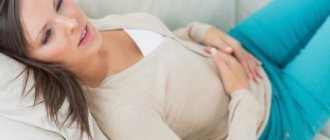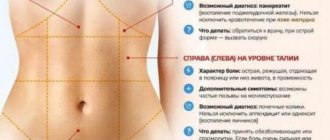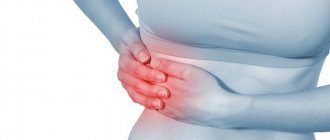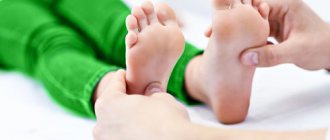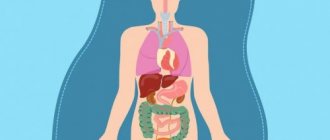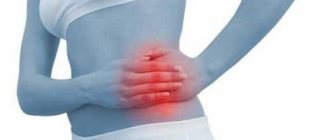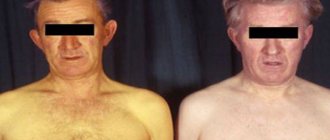A child's body is a developing system that, due to its immaturity, is especially susceptible to infections and viruses. Some diseases especially easily affect children's bodies. Such pathologies include reactive pancreatitis - spasm of the excretory ducts of the pancreas. Today, the concept of “reactive pancreatitis” is not used among gastroenterologists, but it can still be found in pediatric practice1.
Reactive pancreatitis cannot be called a separate disease. Rather, it is a reaction to viral influence, a malfunction of the gastrointestinal tract, or improperly organized nutrition1.
This form of inflammation of the pancreas in children most often develops as a chronic problem, but in cases of systematic malnutrition, an exacerbation of the disease is possible.
Abdominal pain in a small child
The smallest children cannot say this in words, they cry. A baby's crying in the first months of life is often caused by pain in the tummy. Most often it is colic. However, a more serious reason is also possible: in children at an early age (most cases occur at the age of 5-9 months), with certain anomalies in the development of the intestine or the occurrence of intussusception (when part of the intestine enters the subsequent segment, like an umbrella into a cover), intestinal obstruction may occur requiring operative surgical treatment.
Under what circumstances can you not worry?
In most cases, children do not control the amount of food they eat. Especially if the parents prepared a lot of delicious dishes for the holiday. After overeating, a child often feels heaviness and pain in the stomach. This is completely natural and does not require medical attention. After digestion of food, the pain will go away.
If such sensations bother your child after each meal, it is worth reconsidering his regime and diet.
How do you know if your child has a stomach ache?
If the child cannot yet say what hurts, parents have to guess for themselves what is bothering their baby. Small children react to any pain by crying, however, if their tummy hurts, then in most cases this can be determined.
When gas accumulates, the tummy becomes noticeably rounded and becomes hard to the touch. The child pulls his legs towards his stomach, shudders for no apparent reason, and refuses to eat. If such signs appear, do not take risks - show the child to the doctor.
Most common reasons
If a child complains of painful symptoms on the left side, there may be many reasons for this. Only a doctor can find out. Let's look at the most common pathologies that cause this symptom:
- Appendicitis. The appendix is located on the right side, but pain can radiate to the left side. When some organs in a baby are underdeveloped, especially the omentum, the clinical picture changes somewhat. This leads to a delay in surgical intervention. During this time, ordinary appendicitis manages to become destructive.
- Gastritis. It occurs as an inflammatory process of the gastric mucosa. The disease is characterized by pain localized in the upper abdomen or on the left under the ribs. The age period when pathology most often develops is 5-6 and 10-15 years (periods of active growth). In preschoolers, the formation of inflammation is associated with frequent infectious diseases, in adolescents - food from McDonald's, drinks with gas and the presence of negative habits (smoking, drinking alcohol).
- Inguinal hernia strangulation. The pathological phenomenon occurs in children under two years of age. Manifested by increased sweating and pale skin. The child often feels sick.
- Accumulation of feces in the rectum (coprostasis). It is formed due to congenital characteristics of the body. It often causes intestinal obstruction. Typical symptoms here are pain in the upper or lower abdomen of a spasmodic nature.
- Volvulus. It often occurs in newborn babies. Most of them are chubby babies, hyperactive or bottle-fed. Characteristic symptoms here are severe pain, alternating with calm periods, and fever. During painful attacks, the child begins to cry and draw his legs towards his chest.
To avoid the development of such diseases, parents should closely monitor the behavior and condition of the baby and not neglect scheduled visits to the pediatrician.
Abdominal pain in older children (boys and girls)
In older children, abdominal pain may result from:
- overeating and bloating as a result of gas formation;
- stretching of the abdominal muscles as a result of physical activity, as well as attacks of coughing, vomiting, etc.;
- inflammation of the stomach and intestines (gastroenteritis). In this case, pain is often preceded by fever, nausea, vomiting, and after an attack of pain, diarrhea is common;
- ARVI (rotavirus infection, which also has intestinal manifestations);
- appendicitis. Appendicitis is indicated by pain in the navel or lower right side of the abdomen. The temperature may rise, nausea, and slight diarrhea may occur. In case of appendicitis, immediate hospitalization is necessary;
- acute pancreatitis (inflammation of the pancreas). In this case, the pain is usually severe and can radiate to the shoulders, shoulder blades, or encircle. The abdomen is swollen and tense. The child takes a position lying on his side. Immediate hospitalization is required;
- acute inflammation of the kidneys (acute nephritis). In acute nephritis, abdominal pain is accompanied by urinary disturbances (urination occurs more often and in smaller volumes). Urine becomes dark in color. There is swelling under the eyes.
- inflammation of the lower segments of the lungs. Usually in this case, attacks of dry cough are observed before pain appears.
It should be remembered that the child is not always able to show where exactly his stomach hurts, and usually points to the navel area. Under no circumstances should you take painkillers on your own. In case of pain, the child must be shown to specialists to make a diagnosis and decide on further treatment tactics.
Functional problems in the body that cause pain
Pain in the left side often signals the development of various diseases. After all, many vital organs are located in this zone. Discomfort can indicate both a mild inflammatory process and the formation of oncology. Therefore, it is important to send the child to the clinic in a timely manner and conduct an appropriate examination.
Pathologies of the pancreas and stomach
Painful sensations in the stomach area signal inflammation and destructive processes that are the result of the progression of pancreatitis (manifested by a strong process of inflammation). What to do if a child experiences a dull, nagging pain, accompanied by swelling, necrosis, irritation, as well as peritonitis and palpation of organs? Call an ambulance immediately. Most likely, hospitalization will be required.
Important! Such signs cannot be ignored. Sharp acute pain can cause suppuration, the appearance of cystic formations, inflammation of the peritoneum and bleeding.
Spleen diseases
This type of disease develops as a consequence of external and internal trauma to the organ. Painful sensations occur in the lower abdomen and manifest as sharp and sharp spasms. Often the discomfort radiates to the shoulder and shoulder blade. They can intensify during physical activity, or when pressing on the affected area.
The pathology is often accompanied by a decrease in blood pressure, body tremors, shortness of breath, as well as signs of intoxication of the body (nausea, vomiting, diarrhea), and lack of blood. The spleen is mainly affected by infections. Damage occurs as a result of the child suffering from sepsis, malaria, typhus, anthrax and other things.
To ease the baby's condition, place him in a horizontal position, or reclining on his left side.
Renal pathologies
Mostly, diseases of paired organs are characterized by pain in the lumbar region, but often radiate to the left side. The symptomatic picture is complemented by severe hematuria (blood in the urine), swelling in the morning, greenish color of the skin, lack of desire to eat, as well as severe headaches, weakness, fever, chills and fatigue.
The causes of such symptoms, accompanied by pain radiating to the left side, are a severe inflammatory process in the kidneys.
Heart muscle diseases
If persistent pain on the left side develops, cardiovascular diseases may also develop. Such a symptom can signal damage to the coronary vessels, congenital defects or inflammation. The pain is dull, compressive, sharp or cutting in nature. Painful sensations radiating to the left side due to diseases of the heart muscle and its vessels are accompanied by shortness of breath in the child. His breathing quickens. The child may feel a lack of oxygen.
Diseases of the reproductive system
Girls under 6 years of age or older may suffer from pyelonephritis (inflammation of the kidneys), the symptoms of which are complemented by high fever, weakness, chills and aching discomfort in the lower back, extending under the left rib. If emptying the bladder is painful, we can talk about the development of cystitis in growing girls. In a neglected state, blood may appear in the urine. In girls with pain, vulvovaginitis or vulvitis can still be suspected.
Pain on the left side in girls is a symptom of vaginal inflammation. The pathology is expressed by dermatitis, irritation, E. coli, and an allergic reaction.
Boys are characterized by the development of phimosis (exposure of the head of the male genitalia, accumulation of sebaceous glands and the formation of an inflammatory process). Premature boys can develop cryptorchidism, which is the failure of the testicle to descend into the scrotum. If hormonal therapy fails, the boy undergoes surgery.
Neuralgia
Why do painful sensations of a sharp and pulling nature occur under the ribs on the left side? This may be the result of progression of intercostal neuralgia. Develops due to irritation or pinching of the intercostal nerve. Localization of discomfort occurs in the chest, abdomen or between the ribs (both left and right).
The symptoms here are quite pronounced: burning, tingling and numbness of the muscles, tension in the back muscles when coughing, sneezing or while laughing or taking a deep breath. Children also experience increased sweating, numbness, and a sharp change from high to low blood pressure, and vice versa.
Broken ribs
Typically, this type of injury is internal. In case of severe injuries, the skin and organs located under the ribs may be damaged. In such a situation, the baby experiences sharp pain, which intensifies with inhalation and movement. The child also experiences discomfort in the chest area and painful attacks in the abdominal area. By feeling the damaged area, you can detect a swelling, when pressed the child reacts painfully. The baby needs to be urgently taken to the clinic for a full examination and special medical measures.
Chronic abdominal pain in children
Abdominal pain may not be acute, but recurring from time to time. Such chronic abdominal pain is usually caused by one of the following reasons:
- chronic diseases of the stomach and duodenum;
- inflammation of the gallbladder and bile ducts;
- kidney inflammation;
- intestinal parasites;
- food allergies;
- constipation;
- mental instability. Complaints of abdominal pain with reluctance, for example, to go to school, are not always a simulation. Emotional children can actually experience bouts of colic, vomiting, diarrhea may occur, and the child may have a headache, like a migraine.
Diagnostic measures
The clinical picture in the first stages of the formation of various diseases is similar. Therefore, if any pathological signs occur, you need to go to the clinic, where experienced doctors will conduct a medical examination, make an accurate diagnosis, and prescribe further treatment.
If there is pain on the left side, you need to take the child to a urologist. He will conduct diagnostics using devices and prescribe the necessary tests. Girls with severe pain on the left side should be sent to a pediatric gynecologist. The doctor will conduct a visual examination, examine the affected area by palpation, and, if necessary, prescribe laboratory tests. Additionally, a hardware examination may be required.
Important! If your baby experiences constant pain on the left side during physical activity, the student needs to register for group A or B in physical education, adjust the diet, and consult with a specialist.
What are the consequences of back deformation?
Back deformation is not only an aesthetic problem.
The spine is the support of the whole body, it is the support of the chest, so it affects the functioning of most organs. A curved spine is not only a source of pain. This limits the child's physical capabilities and can cause nervous system disorders. Back weakness causes problems with breathing, heart function and can lead to permanent disability.
For mild postural problems, corrective exercises or rehabilitation are sufficient. More severe cases may require an orthopedic brace and even surgery to correct the curvature of the spine.
Cardiac, respiratory, neurological pathologies
The problem of pain radiating to the area of the left hypochondrium may be associated with impaired cardiovascular activity, inflammation of the lungs or pleura, changes in the level of innervation of nerve endings in different parts of the body.
Heart disease and pain from higher in the hypochondrium on the left side
Left-sided pain in a child’s side often indicates a problem with the heart and coronary vessels. Due to congenital defects and anomalies, chronic inflammation, the vascular-capillary network may be damaged, which negatively affects the functioning of the heart muscle. The nature of heart pain is pressing, pulling, but can be sharp and cutting. More often they are concentrated in the upper part of the sternum, but radiate to the area of the left hypochondrium, to the side from the back. Children with heart problems suffer from shortness of breath, rapid breathing, and lack of oxygen. In such cases, consultation with a cardiologist is mandatory.
Pathologies of the lungs and pain in the upper abdomen on the left side
Inflammation developing in the left lung, especially in its lower part, the edge of which is located near the left hypochondrium, provokes pain in the child with a pulling and aching character. The temperature may rise, coughing, and difficulty in deep breathing may occur. Similar symptoms appear with inflammation in the area of the left-sided pleural membrane.
Intercostal neuralgia and strong, throbbing, sharp pain on the left side in a child
Due to compression or excessive irritation of the nerve endings located in the intercostal area, intercostal neuralgia develops. The child complains of a tingling and burning sensation between the ribs, muscles tense when coughing, sneezing, or trying to take a deep breath. A blow to the chest area may cause injury to a child's ribs. A severe bruise or fracture of the ribs is manifested by intense pain in the affected area, which is further intensified by any movement of the body (turning, bending). An examination with analysis of the results of an x-ray examination helps clarify the diagnosis.
Types and types of pain in the left hypochondrium in a child 2, 3, 4, 5, 6, 7, 8, 9, 10 years old
If a child looks lethargic, inactive, and eats without appetite, you need to think about the reasons for his illness. Nagging pain in the left side and left hypochondrium in children is considered as one of the symptoms of the development of digestive pathology. Signs such as diarrhea, bouts of vomiting, elevated body temperature, and distinct paleness of the skin should be a reason to call a pediatrician. Parents may suspect that their child has intense pain due to the uncharacteristic positions that he takes, or lies with his legs tucked to his stomach. In such situations, it is better to call an ambulance. You need to pay attention to the characteristics of the child’s pain syndrome, that is, not only where the baby’s stomach hurts, but also other symptoms and signs:
1 how often does it appear;
2 whether it is associated with physical activity;
3 how long it lasts or is short-term;
4 how hard the child tolerates it (becomes apathetic and sleeps poorly) or does it not significantly affect his behavior (he got sick and immediately stopped);
5 Is pain on the left side related to eating?
Only a doctor can determine the cause of pain in more detail, based on the symptoms of pain described by the child (pulling, sharp, aching, dull, cramping pain, severe or weak pain in the left side, burning or throbbing pain, stabbing or cutting), if the child’s pain is 5 , 6, 7, 8, 9, 10 years and more. But if a child of 2, 3, 4 years old has pain on the left side, then it is very difficult to understand what kind and type of pain the child is worried about. In this case, it is best to perform an ultrasound (ultrasound examination), other diagnostic procedures and the causes of pain in the peritoneum.
What medicines to use when it hurts
The only safe painkillers for children are paracetamol and ibuprofen. Depending on the age and weight of the child, you can choose syrup, suppositories or tablets.
If these medications don't help your pain, only your doctor can decide what to do next.
Warming patches and ointments with anti-inflammatory and analgesic properties are intended for adults and older adolescents.
A child's thin skin allows medications contained in patches or ointments to be easily absorbed, and is too sensitive to the effects of the substances they contain.

